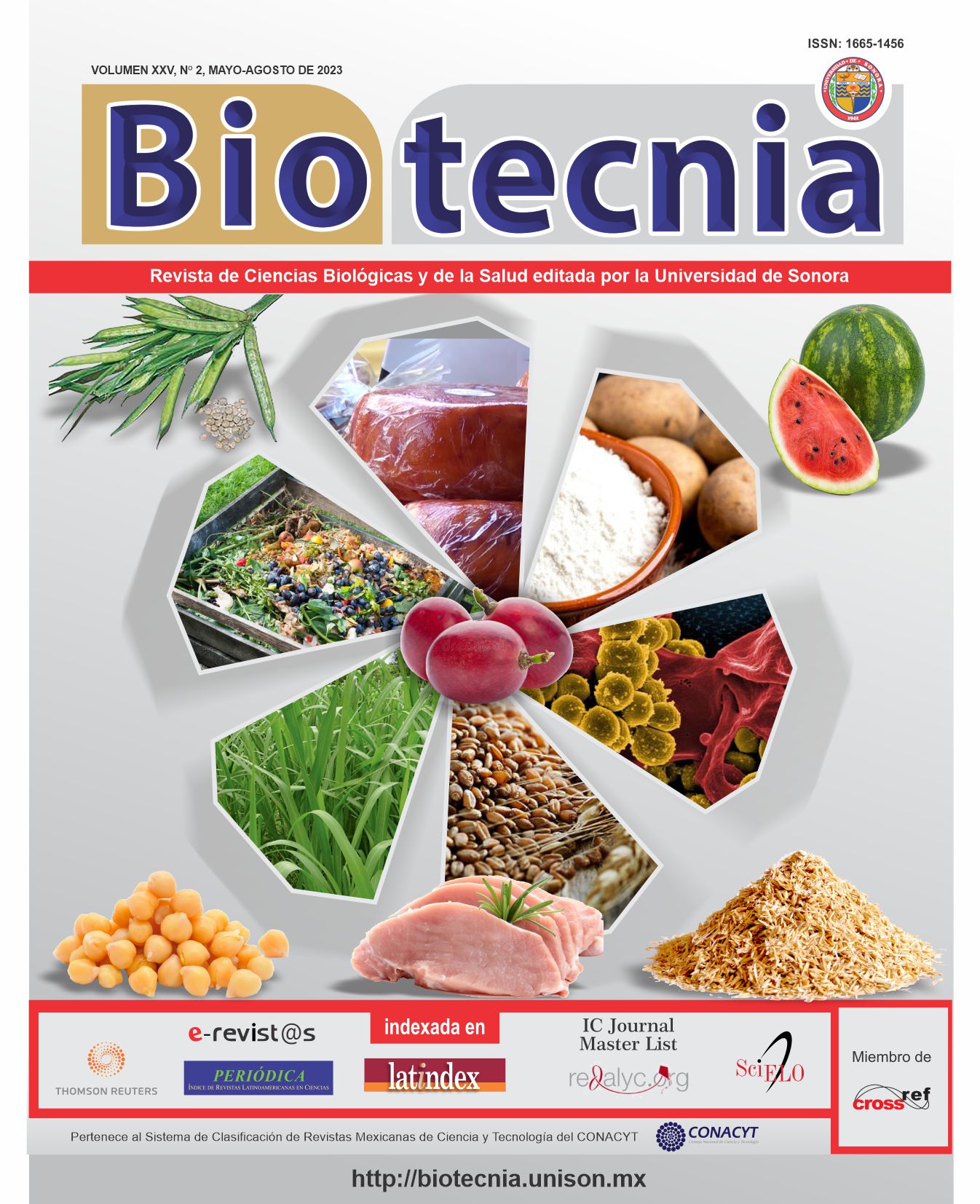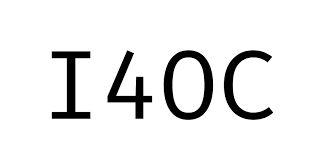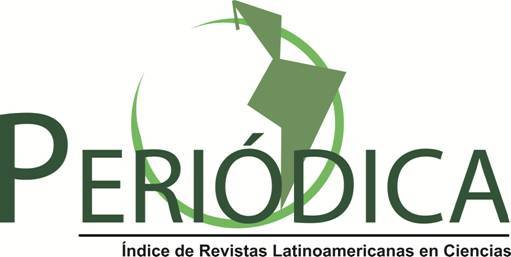Bibliometric analysis of scientific literature on the organic basis Bokashi: alternative in sustainable agriculture
Bokashi: alternative in sustainable agriculture
DOI:
https://doi.org/10.18633/biotecnia.v25i2.1848Keywords:
fermented manure, Harzing's Publish of Perish, effective microorganisms, SCOPUS, VOSviewer.Abstract
The use of bokashi as an organic soil amendment and source of nutrition for plants has received considerable attention in recent years. The bokashi, composting method of Japanese origin, based on the aerobic fermentation of waste through the inoculation of efficient microorganisms; which are anaerobic bacteria and lactic yeasts that speed up the process by shortening the time it takes to obtain the fertilizer. The objective of the research was to develop a bibliometric analysis on Bokashi in SCOPUS. The process was carried out on August 10, 2022 using the search algorithm: (TITLE-ABS-KEY (Bocashi) OR TITLE-ABS-KEY (Bokashi)) linked to the article title, abstract and keywords. The research was carried out using the VOSviewer and Harzing's Publish of Perish software research instrument. The results of the bibliometric analysis registered a total of 161 documents published between the years 1999 to 2022. The main types of publications were 129 articles (80.12%) and 25 conferences (15.52%), 87.58% (141 publications) were in English. Brazil was the country with the most publications (39), followed by Indonesia (31) and Mexico (22). Ventura, M. U. was the most productive author with six articles. In the co-authorship networks, two main networks were found: the first with Fregonezi, G. A. F., Hata, F. T. and Ventura, M. U., and the second with Grądzki, Z. The growing interest in Bokashi as a sustainable alternative in agricultural production systems should allow to establish and build networks of scientific publications, scientific revisits, researchers, research organization, countries and keywords.
Downloads
References
Referencias
Abdul, A. N. I. H., Hanafiah, M. M., y Mohamed Ali, M. Y. (2019). Sustainable biogas production from agrowaste and effluents – A promising step for small-scale industry income. Renewable Energy, 132, 363-369. https://doi.org/10.1016/j.renene.2018.07.149
Alonso, S., Cabrerizo, F. J., Herrera-Viedma, E., y Herrera, F. (2009). h-Index: A review focused in its variants, computation and standardization for different scientific fields. Journal of Informetrics, 3(4), 273-289. https://doi.org/10.1016/j.joi.2009.04.001
Álvarez-Solís, J. D., Mendoza-Núñez, J. A., León-Martínez, N. S., Castellanos-Albores, J., y Gutiérrez-Miceli, F. A. (2016). Effect of Bokashi and vermicompost leachate on yield and quality of pepper (Capsicum annuum) and onion (Allium cepa) under monoculture and intercropping cultures. Ciencia e Investigacion Agraria, 43(2), 243-252. https://doi.org/10.4067/S0718-16202016000200007
Aulinas, M. M., y Bonmatí, B. A. (2008). Evaluation of composting as a strategy for managing organic wastes from a municipal market in Nicaragua. Bioresource Technology, 99(11), 5120-5124. https://doi.org/10.1016/j.biortech.2007.09.083
Babla, M., Katwal, U., Yong, M.-T., Jahandari, S., Rahme, M., Chen, Z.-H., y Tao, Z. (2022). Value-added products as soil conditioners for sustainable agriculture. Resources, Conservation and Recycling, 178. https://doi.org/10.1016/j.resconrec.2021.106079
Bergstrand, K.-J. (2022). Organic fertilizers in greenhouse production systems – a review. Scientia Horticulturae, 295. https://doi.org/10.1016/j.scienta.2021.110855
Boechat, C. L., Santos, J. A. G., y Accioly, A. M. A. (2013). Net mineralization nitrogen and soil chemical changes with application of organic wastes with 'Fermented Bokashi Compost'. Acta Scientiarum - Agronomy, 35(2), 257-264. https://doi.org/10.4025/actasciagron.v35i2.15133
Corrales-Reyes, I. E., Fornaris-Cedeño, Y., y Reyes-Pérez, J. J. (2017). Análisis bibliométrico de la revista investigación en educación médica . Período 2012-2016. Investigación en Educación Médica. https://doi.org/10.1016/j.riem.2017.02.003
Daiss, N., Lobo, M. G., Socorro, A. R., Brückner, U., Heller, J., y Gonzalez, M. (2008). The effect of three organic pre-harvest treatments on Swiss chard (Beta vulgaris L. var. cycla L.) quality. European Food Research and Technology, 226(3), 345-353. https://doi.org/10.1007/s00217-006-0543-2
Formowitz, B., Elango, F., Okumoto, S., Müller, T., y Buerkert, A. (2007). The role of "effective microorganisms" in the composting of banana (Musa ssp.) residues. Journal of Plant Nutrition and Soil Science, 170(5), 649-656. https://doi.org/10.1002/jpln.200700002
Galicia Gallardo, A. P., Ceccon, E., Castillo, A., y González-Esquivel, C. E. (2020). Resisting socio-ecological vulnerability: agroecology and indigenous cooperativism in La Montaña, Guerrero, Mexico. Agroecology and Sustainable Food Systems, 45(1), 65-85. https://doi.org/10.1080/21683565.2020.1793871
Harzing, A. W. (2007). Publish of Perish. https://harzing.com/resources/publish-or-perish
Hata, F. T., de Paula, M. T., Moreira, A. A., Ventura, M. U., de Lima, R. F., Fregonezi, G. A. F., y de Oliveira, A. L. M. (2021a). Organic fertilizations and fertigation with chicken boiled manure for organic crop. Revista de la Facultad de Agronomia, 38(2), 342-359. https://doi.org/10.47280/RevFacAgron(LUZ).v38.n2.07
Hata, F. T., Spagnuolo, F. A., de Paula, M. T., Moreira, A. A., Ventura, M. U., Fregonezi, G. A. D. F., y de Oliveira, A. L. M. (2020). Bokashi compost and biofertilizer increase lettuce agronomic variables in protected cultivation and indicates substrate microbiological changes. Emirates Journal of Food and Agriculture, 32(9), 640-646. https://doi.org/10.9755/ejfa.2020.v32.i9.2142
Hata, F. T., Ventura, M. U., Fregonezi, G. A. F., y de Lima, R. F. (2021b). Bokashi, boiled manure and penergetic applications increased agronomic production variables and may enhance powdery mildew severity of organic tomato plants. Horticulturae, 7(2), 1-8, Article 27. https://doi.org/10.3390/horticulturae7020027
Hata, F. T., Ventura, M. U., Sousa, S., y Fregonezi, G. A. F. (2019). Low-cost organic fertilizations and bioactivator for arugula-radish intercropping. Emirates Journal of Food and Agriculture, 31(10), 773-778. https://doi.org/10.9755/ejfa.2019.v31.i10.2018
Hirsch, J. E. (2005). An index to quantify an individual´s scientific research output. Proceedings of the National Academy of Sciences, 102(46), 16569-16572.
Jaramillo-López, P. F., Ramírez, M. I., y Pérez-Salicrup, D. R. (2015). Impacts of Bokashi on survival and growth rates of Pinus pseudostrobus in community reforestation projects. Journal of Environmental Management, 150, 48-56. https://doi.org/10.1016/j.jenvman.2014.11.003
Laskowska, E., Jarosz, Ł., y Grądzki, Z. (2017). The effect of feed supplementation with effective microorganisms (EM) on pro- and anti-inflammatory cytokine concentrations in pigs. Research in Veterinary Science, 115, 244-249. https://doi.org/10.1016/j.rvsc.2017.03.008
Laskowska, E., Jarosz, Ł., y Grądzki, Z. (2019). Effect of Multi-Microbial Probiotic Formulation Bokashi on Pro- and Anti-Inflammatory Cytokines Profile in the Serum, Colostrum and Milk of Sows, and in a Culture of Polymorphonuclear Cells Isolated from Colostrum. Probiotics and Antimicrobial Proteins, 11(1), 220-232. https://doi.org/10.1007/s12602-017-9380-9
Mayer, J., Scheid, S., Widmer, F., Fließbach, A., y Oberholzer, H. R. (2010). How effective are 'Effective microorganisms® (EM)'? Results from a field study in temperate climate. Applied Soil Ecology, 46(2), 230-239. https://doi.org/10.1016/j.apsoil.2010.08.007
Moreno, R. A., Briceño, C. E. A., Valenzuela, N. L. M., y Hernández, H. J. A. (2019). Abonos orgánicos: una alternativa sustentable en la agricultura. In R. A. Moreno y C. J. L. Reyes (Eds.), Topicos selectos de sustentabilidad, un reto permanente para el nuevo milenio.
Ndona, R. K., Friedel, J. K., Spornberger, A., Rinnofner, T., y Jezik, K. (2011). Effective micro-organisms’ (EM): An effective plant strengthening agent for tomatoes in protected cultivation. Biological Agriculture and Horticulture, 27(2), 189-203. https://doi.org/10.1080/01448765.2011.9756647
Pandit, N. R., Schmidt, H. P., Mulder, J., Hale, S. E., Husson, O., y Cornelissen, G. (2020). Nutrient effect of various composting methods with and without biochar on soil fertility and maize growth. Archives of Agronomy and Soil Science, 66(2), 250-265. https://doi.org/10.1080/03650340.2019.1610168
Pei-Sheng, Y., y Hui-Lian, X. (2002). Influence of EM bokashi on nodulation, physiological characters and yield of peanut in nature farming fields. Journal of Sustainable Agriculture, 19(4), 105-112. https://doi.org/10.1300/J064v19n04_10
Peralta-Antonio, N., de Freitas, G. B., Watthier, M., y Santos, R. H. S. (2019). Compost, bokashi and efficient microorganisms: Their benefits in successive crops of broccoli. Idesia, 37(2), 59-66. https://doi.org/10.4067/S0718-34292019000200059
Pérez-Godínez, E. A., Lagunes-Zarate, J., Corona-Hernández, J., y Barajas-Aceves, M. (2017). Growth and reproductive potential of Eisenia foetida (Sav) on various zoo animal dungs after two methods of pre-composting followed by vermicomposting. Waste Management, 64, 67-78. https://doi.org/10.1016/j.wasman.2017.03.036
Quispe, L. A. (2015). El valor potencial de los residuos sólidos orgánicos, rurales y urbanos para la sostenibilidad de la agricultura Revista Mexicana de Ciencias Agricolas 6(1), 83-95.
Ramos, A. D., y Terry, A. E. (2014). Generalidades de los abonos orgánicos: importancia del bocashi como alternativa nutricional para suelo y planta. Cultivos Tropicales, 35(4), 52-59.
Sandoval-Cancino, G., Zelaya-Molina, L. X., Ruíz-Ramírez, S., Cruz-Cárdenas, C. I., Aragón-Magadán, M. A., Rojas-Anaya, E., y Chávez-Díaz, I. F. (2022). Agricultural genetic resources as a source of resilience in the face of the covid-19 pandemic in Mexico. Tropical and Subtropical Agroecosystems 25(1), 1-26.
Shingo, G. Y., y Ventura, M. U. (2009). Collard greens yield with mineral and organic fertilization. Semina:Ciencias Agrarias, 30(3), 589-594. https://doi.org/10.5433/1679-0359.2009v30n3p589
Sousa, V., Ventura, M. U., Hoshino, A. T., Hata, F. T., y Constantino, L. V. (2021). Development and population growth of the two-spotted spider mite (Tetranychus urticae Koch) on strawberry fertilized with different doses and sources of organic fertilizers. International Journal of Acarology, 47(6), 528-535. https://doi.org/10.1080/01647954.2021.1965655
Urra, J., Alkorta, I., Lanzén, A., Mijangos, I., y Garbisu, C. (2019). The application of fresh and composted horse and chicken manure affects soil quality, microbial composition and antibiotic resistance. Applied Soil Ecology, 135, 73-84. https://doi.org/10.1016/j.apsoil.2018.11.005
van Eck, N. J., y Waltman, L. (2010). Software survey: VOSviewer, a computer program for bibliometric mapping. Scientometrics, 84(2), 523-538. https://doi.org/10.1007/s11192-009-0146-3
Volkov, A., Morkunas, M., Balezentis, T., y Streimikiene, D. (2022). Are agricultural sustainability and resilience complementary notions? Evidence from the North European agriculture. Land Use Policy, 112. https://doi.org/10.1016/j.landusepol.2021.105791
Xu, H. L., Wang, R., y Mridha, M. A. U. (2000). Effects of organic fertilizers and a microbial inoculant on leaf photosynthesis and fruit yield and quality of tomato plants. Journal of Crop Production, 3(1), 173-182. https://doi.org/10.1300/J144v03n01_15
Yamada, K., y Xu, H. L. (2000). Properties and applications of an organic fertilizer inoculated with effective microorganisms. Journal of Crop Production, 3(1), 255-268. https://doi.org/10.1300/J144v03n01_21
Downloads
Published
How to Cite
Issue
Section
License
Copyright (c) 2023

This work is licensed under a Creative Commons Attribution-NonCommercial-ShareAlike 4.0 International License.
The journal Biotecnia is licensed under the Attribution-NonCommercial-ShareAlike 4.0 International (CC BY-NC-SA 4.0) license.

















_(2).jpg)







